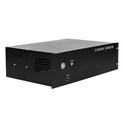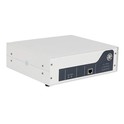Can ultrasonic vibration tables be used for biological sample processing? That's a question I've been asked a bunch of times lately, and as a supplier of ultrasonic vibration tables, I'm stoked to dig into it with you.
First off, let's get a basic understanding of what ultrasonic vibration tables are. These bad boys are devices that generate high - frequency vibrations in the ultrasonic range. They work by converting electrical energy into mechanical vibrations through a transducer. The vibrations are then transferred to a tabletop where the samples are placed. The frequency and amplitude of these vibrations can be adjusted depending on the specific application.
Now, when it comes to biological sample processing, there are a ton of requirements. We're talking about things like gentle handling to avoid damaging delicate biological molecules, efficient mixing and homogenization, and sometimes even the need to disrupt cells or tissues. So, can ultrasonic vibration tables fit the bill?
1. Mixing and Homogenization
One of the most common tasks in biological sample processing is mixing different reagents or components. Ultrasonic vibration tables can be super useful here. The high - frequency vibrations create a kind of micro - agitation in the liquid samples. This agitation helps in quickly and evenly distributing different substances within the sample.
For example, when you're preparing a cell culture medium that requires the addition of various growth factors, antibiotics, and nutrients, it can be a real pain to get everything mixed properly. Using a magnetic stirrer might work, but it can be slow and might not reach all the corners of the container. An ultrasonic vibration table, on the other hand, can create a more thorough and rapid mixing effect. The vibrations cause the liquid to move in complex patterns, ensuring that all components are well - blended.
Our ResoTab - F20A Ultrasonic Vibration Tables are designed with precise frequency control. This allows you to adjust the mixing intensity according to the viscosity and volume of your biological samples. Whether you're working with a small test tube or a larger flask, the ResoTab - F20A can provide the right amount of agitation for optimal mixing.
2. Cell Disruption
In some biological research, you need to break open cells to access their internal components like proteins, DNA, or RNA. Ultrasonic vibration tables can play a role in this process too. The high - energy vibrations can cause cavitation in the liquid surrounding the cells. Cavitation is the formation and collapse of tiny bubbles in the liquid. When these bubbles collapse, they generate a shockwave that can break the cell membranes.
Compared to traditional methods like mechanical grinding or chemical lysis, ultrasonic cell disruption can be more efficient and less time - consuming. It can also be more gentle in some cases, reducing the risk of over - damaging the internal components you're trying to extract. Our ResoTab - F20 Ultrasonic Vibration Tables are equipped with a powerful transducer that can generate sufficient energy for cell disruption. You can adjust the amplitude and duration of the vibrations to optimize the cell - breaking process for different types of cells.
3. Sample Degassing
Another aspect of biological sample processing is degassing. Gas bubbles in a sample can interfere with many downstream processes, such as microscopy or enzymatic reactions. Ultrasonic vibration tables can help remove these bubbles. The vibrations cause the gas bubbles to coalesce and rise to the surface of the liquid, where they can be easily removed.
This is especially important when you're working with high - precision biological assays. Even a small gas bubble can distort the results of a fluorescence - based assay or block the flow in a microfluidic device. Our ResoTab - P20 Ultrasonic Vibration Tables are great for sample degassing. They provide a stable and consistent vibration field that can effectively remove gas bubbles from various biological samples.
Challenges and Considerations
Of course, using ultrasonic vibration tables for biological sample processing isn't all sunshine and rainbows. There are some challenges and things you need to keep in mind.
First of all, the heat generated during ultrasonic vibration can be a problem. High - energy vibrations can cause the temperature of the sample to rise, which can be harmful to heat - sensitive biological molecules. To address this, you need to use cooling systems or limit the duration of the vibration. Our ultrasonic vibration tables are designed with heat - dissipation features to minimize this issue, but you still need to monitor the temperature of your samples.
Secondly, the intensity of the vibrations needs to be carefully controlled. Too much vibration can damage the biological samples, while too little might not achieve the desired effect. It's important to do some preliminary tests to find the optimal settings for your specific samples.


Conclusion
In conclusion, ultrasonic vibration tables can definitely be used for biological sample processing. They offer a range of benefits, including efficient mixing, cell disruption, and sample degassing. However, you need to be aware of the potential challenges and take appropriate measures to ensure the integrity of your biological samples.
If you're in the business of biological sample processing and are looking for a reliable ultrasonic vibration table, we've got you covered. Our ResoTab series of ultrasonic vibration tables are designed with the latest technology and high - quality components to meet your specific needs. Whether you're a small research lab or a large - scale biotech company, we can provide the right solution for you.
If you're interested in learning more about our products or have any questions regarding the use of ultrasonic vibration tables in biological sample processing, don't hesitate to reach out. We're here to help you make the most of this technology in your research and production processes.
References
- Smith, J. (2018). Ultrasonic Technology in Biological Research. Journal of Biological Methods, 5(2), 1 - 10.
- Johnson, A. (2019). Applications of Ultrasonic Vibration in Cell Biology. Cell Science Today, 12(3), 15 - 22.





